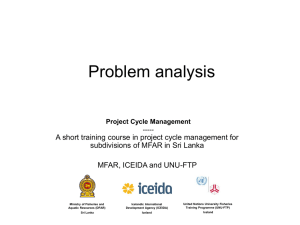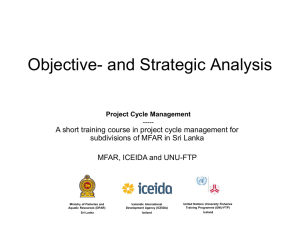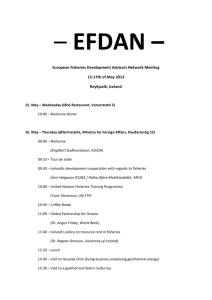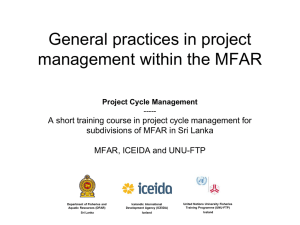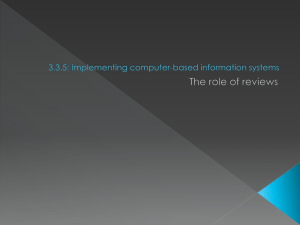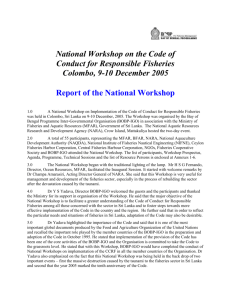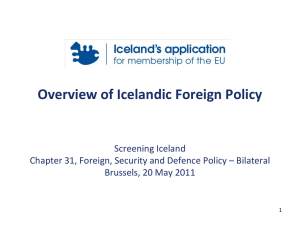Evaluation, Audit & Review of projects
advertisement
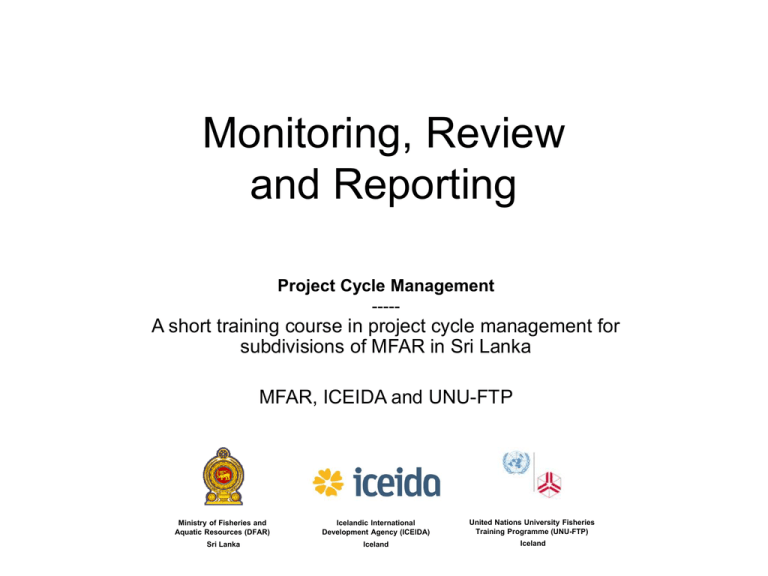
Monitoring, Review and Reporting Project Cycle Management ----- A short training course in project cycle management for subdivisions of MFAR in Sri Lanka MFAR, ICEIDA and UNU-FTP Ministry of Fisheries and Aquatic Resources (DFAR) Icelandic International Development Agency (ICEIDA) United Nations University Fisheries Training Programme (UNU-FTP) Sri Lanka Iceland Iceland Content • The role of monitoring, review and reporting in the logical framework approach Learning objectives • After this lecture participants should understand the importance of and the difference between monitoring, evaluation and auditing Implementation stage • The purpose of the implementation stage is to: – deliver the results – achieve the purpose(s) – contribute effectively to the overall objective of the project • Manage the available resources efficiently • Monitor and report on progress Implementation - a learning process Everything that can go wrong, will go wrong - Murphy’s law • How will we respond? • How can we learn from mistakes? Purpose • Monitoring, review and reporting are core management responsibilities which involve the collection, analysis, communication and use of information on the physical and financial progress of the project and the achievement of results Monitoring • Is the systematic and continuous collecting, analyzing and using of information for the purpose of management and decision-making • Monitoring should focus on: - Physical progress - Financial process - The preliminary response by target groups to project activities - Reasons for any unexpected or adverse response by target groups and what remedial action can be taken Monitoring • There are many ways to monitor the process of projects • Sometimes people will just make informal inquiries to get feedback from the people who are doing the work, especially if there have been problems involved in the project - How likely is it that the next milestone will be completed on time? - How is the moral? - Did something “ridiculously” unexpected come up? - Etc. Monitoring • Projects are monitored in different ways depending on: - The size of the project • How much it costs • How much resources are being used - Who is the “owner” of the project? • How are things done normally? - Who are the counterparts? • Do the counterparts have set procedures on how they review progress of projects? - How formal communications have to be? • Do I meet the boss at the bar or send a formal report? Review • The main purpose of reviews is to share information, make collective decisions and re-plan the continuation of the programme as appropriate • Involves regular reviews to provide the opportunity for project implementers and other key stakeholders to further analyze information collected to: - Monitor - Reflect on the implications - Make informed decisions - Take appropriate management action to support effective implementation Review and counterparts • Counterparts such as NGO’s, development agencies and international development funds need to know if their funds are being used in an appropriate way • They will also need to have some means to evaluate what they are doing and document it in a consistent way so they can have consistent useful information Evaluation • Evaluation can be distinguished form monitoring and regular review by: – Its broader scope – It is less frequent – Usually at completion or ex-post – Those involved • Usually involves external or independent personnel – The users of the results • Planners and policy makers concerned with strategy policy and programming issues rather than just managers responsible for implementation Audit • Audit can be distinguished from monitoring, regular reviews and evaluation by: – Its objectives • To provide independent assurance – Its scope • Financial focus or focus on the efficiency, economy and effectiveness of activities – Those involved • Qualified independent auditors – The users of the results • For donors, partner country authorities and senior project managers How? • The logical framework approach is an extremely effective tool to support the design and establishment of effective monitoring, review and reporting systems through: - Analysis of an existing situation Objectives Indicators and targets Assumptions Activity-, resource-, and budget schedules LFA helps the design of monitoring, evaluation and audit Reporting • We have to be able to document status, success or failure whether it is for a small components or full detailed final reports • All documentation is designed and decided in the planning process so people involved should know - what reports should be written what the reports should include when reports should be finished who should be responsible and there should be time available for the writing and included in the schedules Project Completion This essential final stage is to ensure efficient closure of the project, and should: • Confirm whether all project objectives have been achieved • Ensure that best practice experience is recorded and transferred to standards for future projects – project methods – management practices – strengths & weaknesses • Ensure that benefit realisation plans are in place – expected benefits – responsibilities for achieving – timetable & measurement plan • Recognise achievement Learning from projects • The last stage of the project cycle is Learning from the project and evolving • This is the stage which is most often omitted by organisations running projects • This is often because organisations have not internalized monitoring and evaluation as a way of thinking References • European Commission (2004). Project Cycle Management Guidelines. Downloaded 1st March from: http://ec.europa.eu/europeaid/qsm/documents/pcm_ manual_2004_en.pdf
